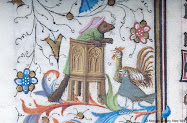As you all know by now, my first love is all things medieval (closely followed by the Renaissance). So I was quite surprised to be so taken with a place the history of which stretches back 6000 years to the Neolithic period. This was the Cairn du Petit Mont, a site comprising several enormous stone-built cairns containing what were probably burial sites. The first cairn was built around 4500 BC, and the others added to it over time to create a massive mound on a point commanding a view right around the Golfe du Morbihan (although apparently, back when the cairn was in use, large areas that are now under water were arable land cut through by a series of river channels). The chambers are incredible feats of architectural engineering, with massive stone slabs used as lintels, floors, walls and doorways, and even what looks like a processional stairway. In between, the walls are filled out with smaller stones that have been so beautifully cut and finely fitted together, no mortar is needed. It is just as impressive in its own way as a cathedral. In fact, with its solid grace and simplicity, it put me in mind a little of being in the nave of one of those wonderful early Romanesque churches you find in France.
There are carvings on the slabs that form the walls and although the ones in the oldest chamber are very difficult to make out now, the ones in the other chamber (ca. 2700 BC) are much clearer, and include images such as a sun and snake-like forms. There is also an image that formerly was interpreted as a female fertility deity but which, 'after further recent study', is now thought to represent a phallus. I wonder if this is a reflection more of the image itself or of the people studying it!
The place must have been perceived as having some serious sacred power, because it seems it was re-used in the Gallo-Roman period for a divinity cult. Sadly, the whole site suffered a dreadful insult during World War II, when the Germans decided the Mont made a perfect surveillance spot and whacked a bloody great bunker right through the middle of it. This obliterated one of the cairns, and cut into the walls of one of the others. It is very jarring to be peering at a 6000 year old rock carving and suddenly notice a big chunk of concrete next to it!
After our visit to Petit Mont, we ducked down to nearby Port Navalo, a little fishing port lined with cafes and seafood restaurants. (I admit it! I had another galette buerre sale and more rose!) Port Navalo is on a thin spur of land so on one side is the port, surrounded by low rocky cliffs that are topped by a good walking track with views across to Quiberon and out into the Golfe du Morbihan. Around the point is a crescent of white sandy beach, sheltered from the prevailing wind and with incredibly clear bright aqua water. You can't move in this area during the high season of July and August, but at the moment it is not too bad and seems to be mostly locals rather than tourists from England and Paris. I would love to come back here in the winter and experience the Atlantic storms beating against this coast. The massive stone breakwaters in the ports and the stoutness of the fishing vessels tell the story that while it may seem very gentle now, it gets really elemental and wild when summer comes to an end.
Subscribe to:
Post Comments (Atom)




No comments:
Post a Comment